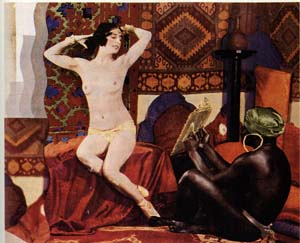
The cumulative effect of these major revolutions in thought was
both a move to perceive humankind as essentially alienated,
controlled by hidden forces, and alone in the universe. The
facination with the unconscious led literary authors to experiment
with language and genre in order to give voice to these hitherto
unexplored areas of experience and language. Who, at
school, has not been gripped by the sharp clarity of the language and
imagery of The Love Song of Alfred J. Prufrock
by T.S.Eliot
and not had the shock of recognition at its exposition of
alienation? |

One of my favourite novels from the period in which these ideas took root in the Western world - the Modernist Period - is The Waves, by Virginia Woolf. This novel is structured differently from the standard Nineteenth century novel which featured a central and omniscient narrating voice. This latter narrator had access to the minds of the novel's characters and drew the tale together by its distinct consciousness and unified interpretation. To Woolf, and many others, this narrative structure did not reflect reality where events do not always work towards a resolution and where each individual's perception of events is as real as that of any other's. Woolf's novel then is narrated by six different voices who reveal themselves through flashes of immediate impressions, snatches of thought and responses to the other members of the group. The voices first emerge in a period of childhood and the language is steeped in the sharpness of sensory impressions particular to children. As a type of metaphor for the creative voice, one of the characters - Bernard - tries to construct some meaning out of the various lives of his friends but fails to conclude his work. |
  New England Literature:
New England Literature: Another period of literature which I find highly refreshing and stimulating is that of mid-Nineteenth Century North America, sometimes called the American Renaissance. The canonical writers of that period are Herman Melville , Nathaniel Hawthorne , Edgar Allen Poe , Emily Dickinson , Henry David Thoreau and Walt Whitman . Thoreau's Walden was my bible at a certain point of time. All the works from this group were influenced by Transcendentalism and the urge to create a langauge and literature independent of that of Europe: their works explode with challenges to literary conventions and perceptions of the human condition. I have particulary enjoyed Moby Dick (Melville) and The Scarlet Letter (Hawthorne). Moby Dick seems as wide as planet earth, with the globe-wide hunt for the whale mirrored in the vast range of literary styles employed. Some see the novel as an allegory of democracy, others as a work in the Shakespearean tradition of the tragic hero being overcome by his own error - in this case that of Ahab's blind pride and his determination to revenge himself on the whale. The Scarlet Letter takes us into the world of Puritan New England with the condemning of the adulteress Hester to a life of social exclusion. Hester takes with her her daughter Pearl. The father of the child, Dimmesdale - a minister whom the community see as saintly - finds himself subjected to tortures of conscience and he finally confesses his guilt publically. Again, the unique use of novelistic conventions to reveal the heart of darkness which tortures the human heart fills the novel with charge and imaginative immediacy.
A Favourite Book: Related links: |
 Home
Home
 Contemporary Literature:
Contemporary Literature: